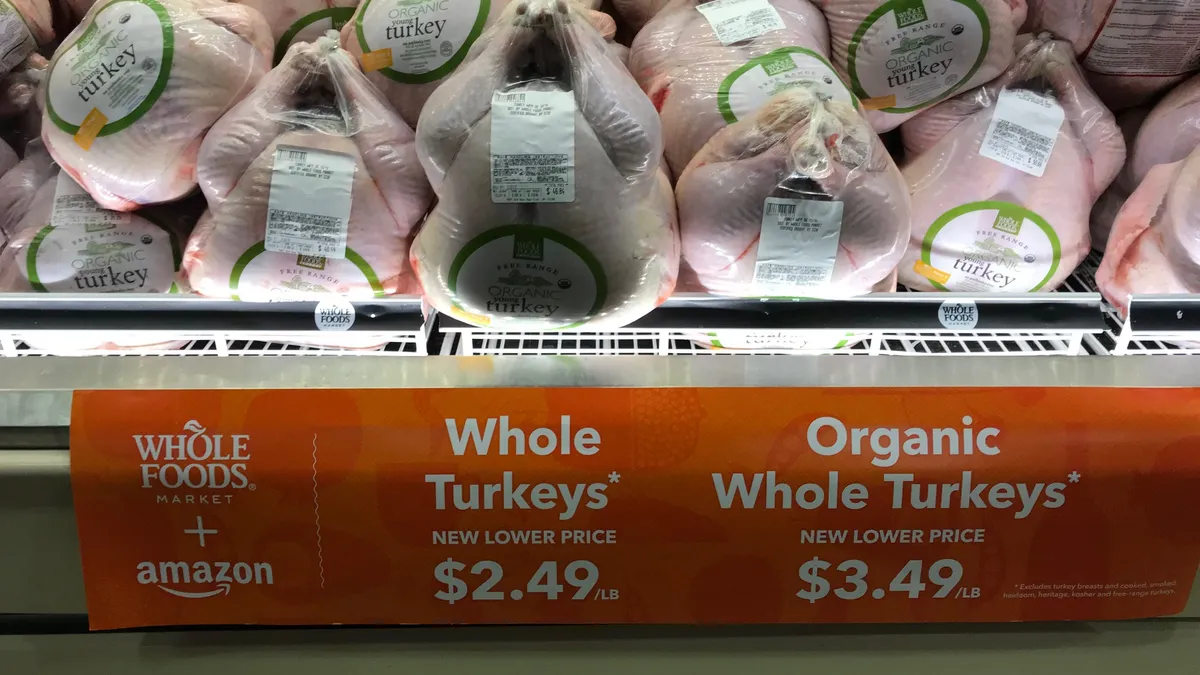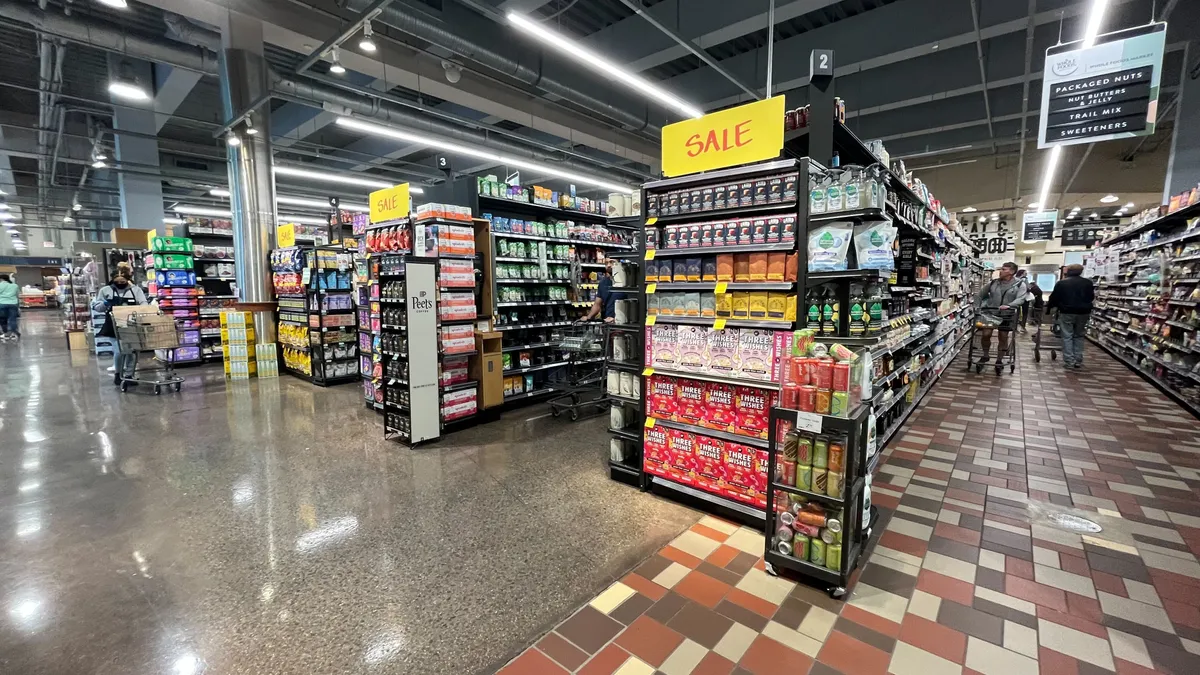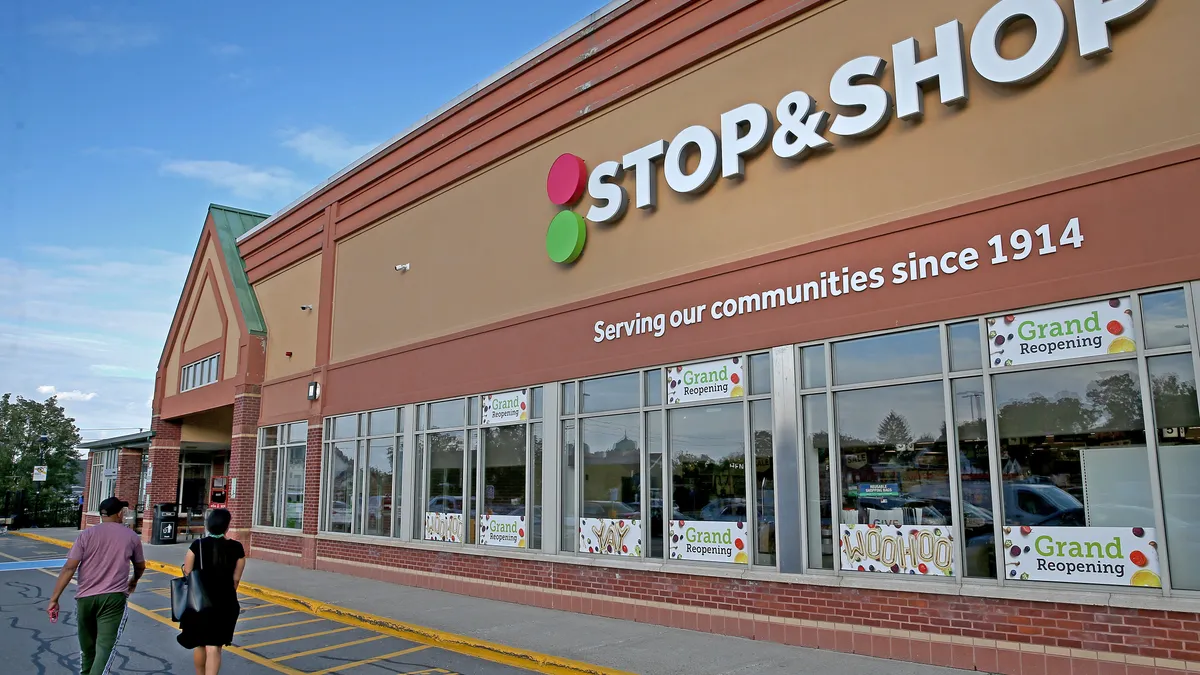Dive Brief:
- Amazon announced another round of price cuts at Whole Foods stores yesterday, focusing on holiday staples along with more than a dozen grocery products, according to a company release.
- Fresh organic turkeys will be sold for $3.49 per pound, while antibiotic-free turkeys run $2.49 per pound. Prime members will get further discounts that bring the prices down to $2.99 per pound (14% off) and $1.99 per pound (20% off) for organic and antibiotic-free turkey, respectively. This marks the first integration of the company’s Prime loyalty program, and provides a “sneak preview of the special savings and in-store benefits Prime members can expect,” according to the release.
- Among the holiday staples getting discounted are organic sweet potatoes, 365 brand canned pumpkin and organic russet potatoes. Amazon will also lower prices on national brand products like Tom’s of Maine toothpaste, Lundberg Farms organic rice, Organic Valley milk and Chobani yogurt. A price check conducted by Food Dive showed discounts as high as 41% on items.
Dive Insight:
As with its first round of price cuts, Amazon will be looking for a healthy traffic boost. The question is, will these cuts — along with highly anticipated Prime membership deals — finally start chipping away at Whole Foods' "Whole Paycheck" image and keep shoppers coming back?
It's possible. The price cuts could make a strong impression as consumers gear up for the holiday season, and begin to hunt for the most competitive prices on turkeys, pies and other holiday staples. Grocers across the industry saw their share prices falter after the announcement, with Kroger and Sprouts Farmers Market taking the largest hits.
Just like its previous round of discounts, which hit stores on August 28, the day Amazon took over Whole Foods, cuts appear throughout the store. At the grocers’ Upper East Side location in Manhattan, a six-pack of large Organic Valley eggs was $2.89, down from $3.79, while bags of Lundberg long grain brown rice were $4.49, down from $6.39. In the meat case, bone-in beef rib steaks were going for 19% off at $12.99. Here’s a rundown of ten price cuts from the Manhattan location:
Prices at Whole Foods' Upper East Side Location
| Product | Old $ | New $ | % Savings |
|---|---|---|---|
| Sweet potatoes (per lb) | $1.99 | $1.49 | 25% |
| Bagged fingerling potatoes | $4.99 | $3.99 | 20% |
| 365 brand diced tomatoes (14.5 oz) | $1.69 | $1.49 | 12% |
| Vital Farms one dozen eggs | $8.99 | $6.99 | 22% |
| Siggi's yogurt cups | $1.99 | $1.59 | 20% |
| Organic Valley 2% milk (1/2 gallon): | $5.49 | $4.19 | 24% |
| Bone-in beef rib steak (per lb) | $15.99 | $12.99 | 19% |
| Lundberg long grain brown rice | $6.39 | $4.49 | 30% |
| Eden Organic assorted beans (15 oz.) | $2.79 | $2.49 | 11% |
| Bagged shrimp (26-30 count) | $16.99 | $9.99 | 41% |
Amazon is also rolling out its first Prime loyalty integration on fresh turkeys in its latest price cuts. The company notes in its release that this is just the first of many Prime offers to come. Considering more than 80 million Americans are enrolled in the service, including many Whole Foods shoppers, this represents one of the company’s greatest threats to competing grocers. Amazon can use Prime to get these shoppers to buy more, and can draw in new customers with deals on groceries and gadgets.
Amazon’s first round of price cuts boosted traffic to Whole Foods by 25% in the first week, data from Foursquare showed, and a similar if not greater boost will likely come with these latest discounts. Time will tell if the cuts will capture shopper loyalty — data shows that the grocers’ traffic moderated less than a month after Amazon took over.
Much will depend on the impact these cuts and subsequent Prime deals have on overall prices. Analysts noted this fall that Amazon’s promotional cuts were accompanied by price boosts in other categories, and had little impact on stores’ average prices. This fact was not lost on consumers, who can easily comparison shop and switch to other stores.
In addition to its price cuts, Amazon is also looking to boost traffic by selling gadgets and offering pop-up shops at select stores. The e-tailer is likely hoping the two promotions work hand-in-hand, and that its grocery discounts will ultimately result in increased sales of its higher-margin Kindles, Fires and Echo Dots.
Looking at the bigger picture, it seems price cuts are secondary to broader strategy that incorporates Whole Foods as part of Amazon’s grocery ecosystem. The company has streamlined its buying structure, moved more Whole Foods products onto its site and co-branded almost every sales sign and price tag in-store with both companies’ names. Amazon is a very visible owner, and that’s because it wants to apply its technology, products and online delivery know-how to the Whole Foods experience. If the e-commerce giant can deliver on an engaging new shopping experience, it may not need to have the lowest prices around to draw consumers.










